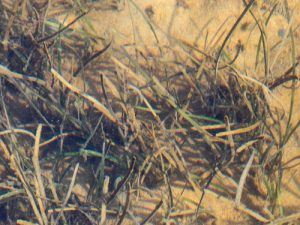
An alliance of federal and state agencies, non profit organizations, and others have begun submerged aquatic vegetation (SAV) planting in Broad Bay, near First Landing State Park, within the Lynnhaven River watershed.
The SAV planting is part of the Lynnhaven River Basin Ecosystem Restoration Project, a multi-phase plan to improve the Lynnhaven River’s habitat and water quality, which may significantly increase Chesapeake Bay Watershed resiliency.
The Chesapeake Bay Foundation, another project partner, will be installing a small fringe reef in the form of low profile reef structures to help protect the SAV plantings.
According to officials, restoring SAV with this pilot project is scheduled to occur alongside wetlands and oyster habitat restoration in the Lynnhaven area as Phase 1 of the project.
By simultaneously restoring the three habitats: SAV, wetlands, and oyster reefs, biologists hope to significantly improve the estuarine bionetwork.
Norfolk District and Virginia Beach plan for Phase 1 SAV restoration to include:
- hand-broadcasting seeds during planting and evaluation of eelgrass and widgeon grass
- post-planting survey to measure success replanting areas lacking 15% coverage
- continuation of adaptive management and monitoring
The project is a combined push by multiple entities: Norfolk District, U.S. Army Corps of Engineers; city of Virginia Beach; Virginia Institute of Marine Science and the Chesapeake Bay Foundation, which is scheduled to install a single-row of small fringe reef structures for protection and wave attenuation.
These indigenous sea plants, although a critical part of the coastal ecosystem, have decreased steadily over the last 35 years, according to VIMS.
According to the Chesapeake Bay Program, SAV “provides food and habitat to wildlife, adds oxygen to the water and traps sediment and nutrient pollution.” Additionally, underwater grasses help reduce shoreline erosion.
Certain conditions must exist in order for SAV to grow successfully. According to the Virginia Department of Environmental Quality, factors such as temperature, light penetration, water depth, currents, and bottom sediment directly impact SAV distribution.
To maximize the probability of the seagrass’ success, USACE Norfolk istrict reached out to experts in the field. The Virginia Institute of Marine Science partnered with the district to spearhead collection and transplant operations.
VIMS, the marine science graduate school for William & Mary, is serving as technical expert due to its experience in seagrass restoration. In 1978, VIMS researchers began investigating techniques for reintroducing eelgrass to areas where it had been eliminated.
Program director Robert Orth said underwater grasses are used as a barometer of Bay health because their growth depends so much on clear, sunlit water. “They’re a ‘canary in the coal mine’ for the Bay,” he added. VIMS successfully harvested enough widgeon grass and eelgrass seed to conduct a pilot planting this year to inform future SAV restoration efforts in Phase 2 of the project.
If successful, a portion of the seeds will be slated for transplant next year adjacent to First Landing State Park. In addition to the planting, VIMS established a water-monitoring station within the area of the newly planted seeds.
Although the Army Corps of Engineers planned this project to improve the quantity and quality of multiple types of habitat, another benefit of the project will be improved water quality.
The Environmental Protection Agency set pollution limits a decade ago that would restore water quality in local rivers, streams and the Chesapeake Bay by 2025.
The Lynnhaven River is targeted for large-scale restoration as part of the 2014 Chesapeake Bay Watershed Agreement.
Federal, state, local agencies, as well as non-profit organizations, such as Lynnhaven River Now and CBF are collaboratively working to help the Lynnhaven River achieve these goals for the benefit of citizens who enjoy the river.
Virginia joined six states and the District of Columbia to formulate the Chesapeake Bay Clean Water Blueprint. This document outlines the limits, plans, milestones and consequences for the seven partner states. As laid out in Executive Order 13508, Chesapeake Bay Protection and Restoration, and again in the 2014 Chesapeake Bay Agreement, the Lynnhaven River is designated as a “priority” tributary and has been identified as one of 10 tributaries to be restored by the year 2025.
The Lynnhaven River Basin Ecosystem Restoration Project addresses the agreement’s five critical goals:
• Abundant Life – Ensure sustainable populations of finfish, shellfish, and other living creatures; the restoration of habitats where those creatures live and feed; and a balanced ecosystem network.
• Clean Water – Reduce nutrient pollution to achieve water quality that can support aquatic life; free the bay and its tributaries from the effects of toxic pollution, not just nutrients; and sustain healthy sub-watersheds.
• Climate Change – Increase the resiliency of the bay and tributaries to withstand changing weather and the impacts it will bring.
• Conserved Lands – Conserve working forests, farms, maritime communities and lands with cultural and other values.
• Engaged Communities – Increase public involvement in bay stewardship; expand public access to the bay; enable environmentally literate students to graduate from high school.
The U.S. Army Corps of Engineers began planning in 2005 and presented the project to the City of Virginia Beach in 2009. A feasibility report and environmental assessment was completed in 2013. In 2016, leases were obtained by the city as potential sites were identified.
Public meetings have been conducted throughout the 15 years of the project timeline including most recently in 2018 and 2019. The Norfolk District has placed signage informing boaters to avoid the small fringe reef, as well as indicating access points. They do not anticipate restricting usage of the area but want to inform residents of the reef and the SAV efforts at the site.
sources: U.S. Army Corps of Engineers Norfolk District